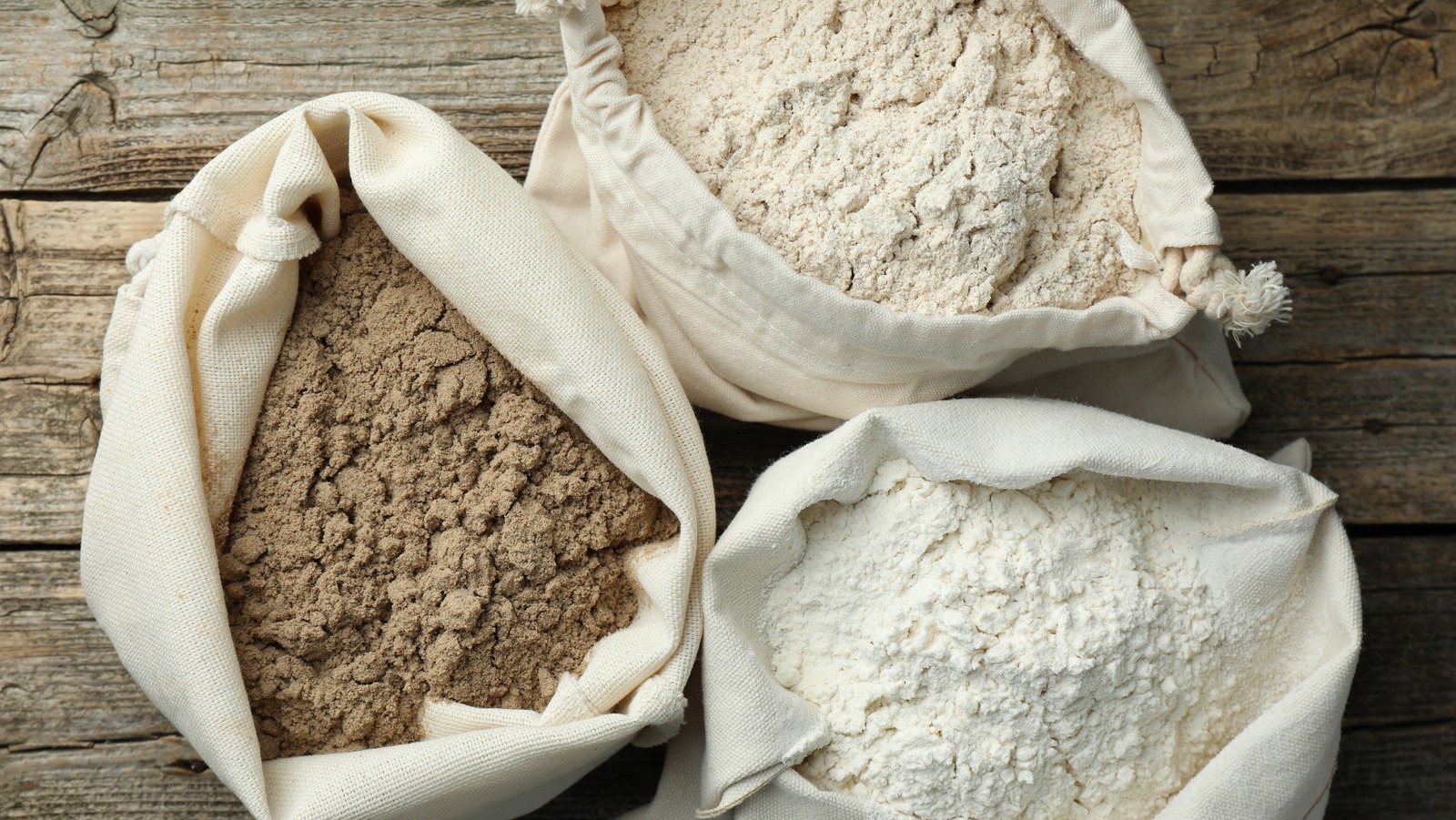Many of us keep a bag of flour in the pantry at all times, even if we don’t use it that frequently. You never know when it’ll come in handy, so keeping some on hand is a smart move. However, flour has a shelf life and can go bad after about three to eight months. The type of flour matters, but proper storage in an airtight container, fridge, or freezer prolongs shelf life. Still, if you’ve ever reached for a bag of flour in the back of your pantry and wondered whether or not it is still good, you aren’t alone. Fortunately, there will be signs when your flour goes bad. If you spot any of them, it is time to toss your flour in the trash, no questions asked.
What are the warning signs that indicate flour has gone bad? I checked in with two experts on the matter to find out: Jessica Randhawa, the owner and head chef of food blog The Forked Spoon, and Jessie-Sierra Ross, a cookbook author and the woman behind food blog Straight To The Hips, Baby. Keep reading to find out what they said about flour’s spoilage warning signs, and you’ll never have to question an old bag of flour again.
A sour or musty smell
One of the most obvious signs indicating flour has gone bad is a sour or musty smell. According to Jessica Randhawa, “Fresh flour should smell neutral, or slightly nutty in the case of whole wheat.” When you detect anything else, it’s a good sign that the flour is rancid. Flours that contain natural oils, like whole wheat or almond, are particularly likely to emit an unpleasant odor when they turn. “That odor comes from oxidation or possible mold growth and is a sure sign it’s time to toss it,” says Randhawa.
Jessie-Sierra Ross confirmed what Randhawa told me and said a variety of factors, like humid storage and more, impact the freshness of flour. Regardless, she recommends playing it safe when it comes to an unpleasant odor: “If your flour smells even a little bit off, you can count on your baked goods tasting off as well. Better to trash that flour than serve it to your friends in your next batch of muffins!”
The presence of bugs or small clumps that resemble webs
Bugs, or any byproduct of them (webs, eggs, etcetera), are a major warning sign that the flour should be thrown in the trash. Interestingly, more than one type of bug is drawn to flour. As Jessie-Sierra Ross tells me, “One of the most common pantry pests is a little winged bug with a big appetite; flour moths.” Also called pantry moths, they spread like wildfire if left unchecked.
According to Ross, weevils are another pantry pest that only causes trouble: “These tiny dark brown bugs (and their eggs or grubs) aren’t poisonous if accidentally eaten, but weevils can leave a mess in your flour, and more importantly, impact its quality.” Whether you come across weevils or pantry moths in flour, you need to toss it out immediately. Jessica Randhawa says, “Even if you don’t see live bugs, tiny holes in the packaging or specks that move when stirred can be a giveaway.”
Both Ross and Randhawa recommend storing flour in an airtight container to prevent pest infestations. Ross also recommends freezing your flour for a few days before putting it in the pantry because “the cold temperatures will destroy any eggs that might be included in the flour, so an outbreak is nipped in the bug… I mean bud.”
Changes in color or texture
Changes in the color and texture of flour are also something to be wary of. When fresh, flour ranges from bright white to beige, and the texture is powdery. Anything less, and you may want to consider tossing it out. As Jessie-Sierra Ross tells me, “If you notice that your flour has any dark spots, looks a little grey, or worse, seems a bit yellow, your product may not be fresh enough to use.” She also recommends looking for signs of mold, which often present as dark brown spots.
Jessica Randhawa backs up what Ross tells me and notes that clumps indicate moisture exposure. As we all know, moisture is a precursor to mold, and nobody wants to eat that. She also points out that “mold isn’t always visible as fuzzy patches either; sometimes it appears as subtle discoloration or streaking.” With this in mind, any signs of discoloration are reason enough to toss your flour in the trash. Don’t even think about simply sifting your flour to remove the clumps, either.
The best by or expiration date has passed
Flour, like other food products, comes with an expiration or “best by” date printed right on the packaging. Even if you don’t detect any of the other warning signs on this list, it’s best to be aware of these printed on dates. Jessica Randhawa tells me, “While it doesn’t instantly go bad after that date, it’s a good reminder to evaluate its condition, especially if it’s been stored in warm or humid environments.”
Expiration dates are not a hard line in the sand. They are more like predictions or suggestions, and they come with a bit of wiggle room. You don’t have to immediately toss your flour if the date has passed. In fact, according to Jessie-Sierra Ross, “most flours can stay fresh for nine to 12 months easily, with all-purpose flour reaching 24 months of standard shelf life if properly stored!” She also notes that whole grain, rye, and high protein flours tend to spoil or expire faster due to an abundance of oils or a high gluten content, but either way, flour lasts a long time — often much longer than the printed date suggests. “When in doubt, use the label as a guide and give the flour a good sniff test. If the proteins or fats have oxidized, your nose will know,” says Ross.
The packaging is damaged
There are many ways for the packaging on a bag of flour to get damaged. Not all damage is a need for concern, but sometimes it is. As Jessie-Sierra Ross tells me, “Accidents happen even to the best of us. Maybe your bag of flour was accidentally damaged, or placed in some spilled oil or milk from your last pancake breakfast.” However, if you simply put it back in the pantry as-is, the chance for moisture damage and spoilage only increases.
Ross also divulges another all too relatable scenario about damaged packaging: “Sometimes we don’t even realize until after we get home from the supermarket that our 20-pound bag has a big tear in the side, and is slowly expelling puffs of powder everywhere. We don’t know where, and more importantly, when, in the packaging-shipping-buying process that it happened.” As a result, it’s a reason to investigate further. Ross recommends pouring flour with damaged packaging into a large bowl and looking for the other signs of spoilage we have discussed thus far, changes in texture, color, and smell. “If anything like that pings your radar, discard the flour — you’re better off safe than sorry,” says Ross. After all, you don’t want to spend a bunch of time and effort making an elaborate dish like restaurant-worthy fried chicken or something else only to have one pesky ingredient ruin it for you.
The flour tastes bitter, metallic, or off in some way
If you don’t notice any of the warning signs described above, but still aren’t sure about a particular bag of flour — maybe it’s way past the “best by” date — you can also give it a small taste test to determine quality. Tasting flour as-is sounds strange. I mean, it definitely isn’t the kind of ingredient you consume raw. Still, Jessica Randhawa tells me that tasting just a small pinch can actually tell you quite a bit about a flour’s freshness.
According to Randhawa, “Old flour can taste bitter or metallic, especially if it contains oils that have gone rancid.” If you detect any other flavors, or it just doesn’t taste right, she said you’re better off just tossing it in the trash. She reaffirms the importance of this by telling me, “Flour is the foundation of so many recipes, and starting with a fresh, clean base is essential to flavor and food safety.” So, try as you may to pull off the perfect soft chocolate chip cookies or any other recipe, the freshness of your flour can easily ruin the taste in the end. It’s best to just pick up a fresh bag if you’re uncertain.





